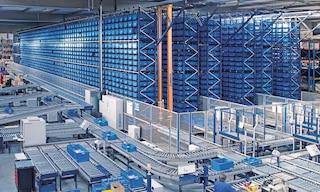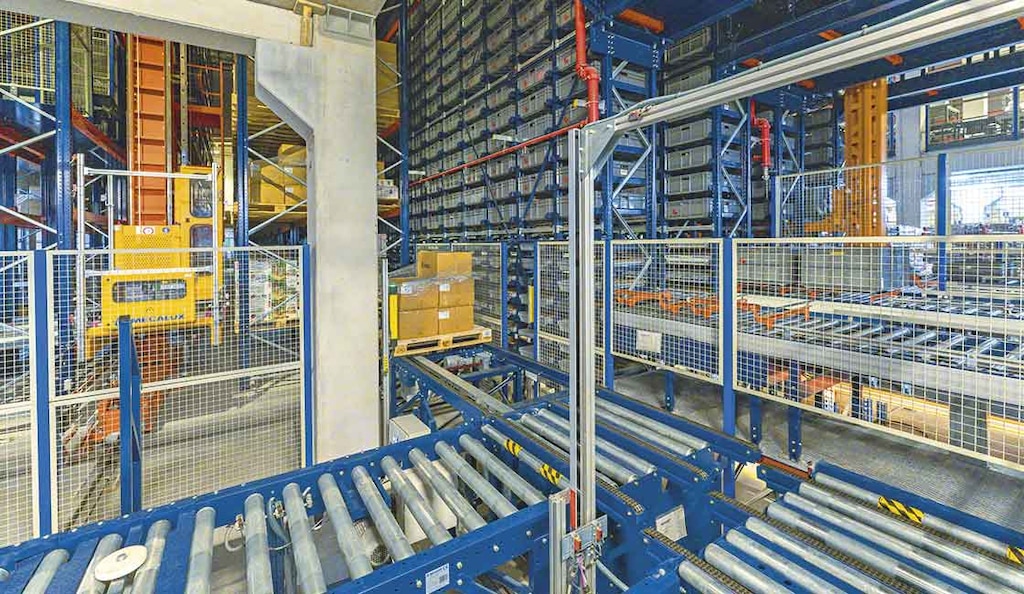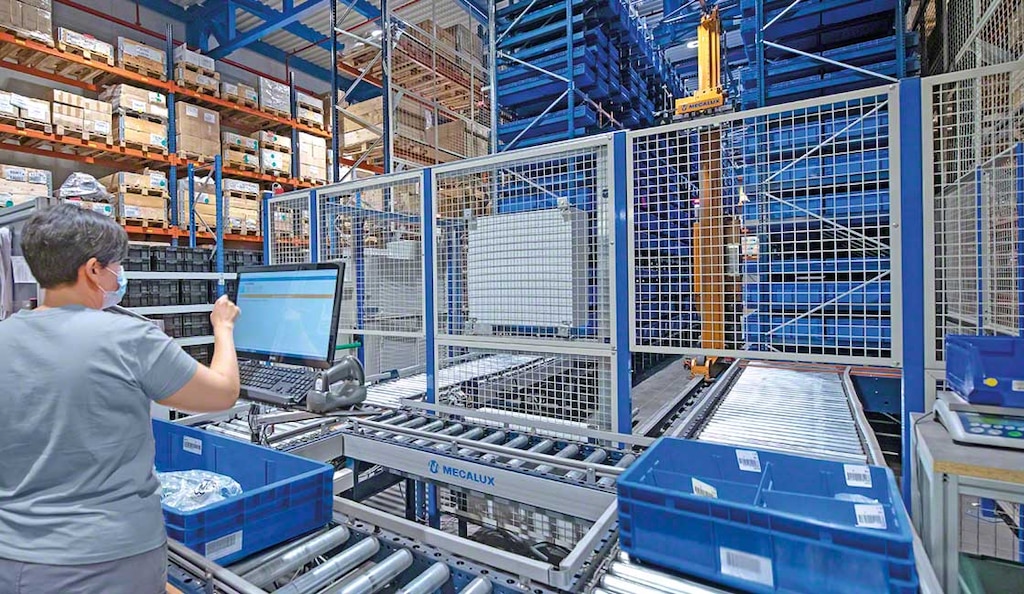
The warehouse of the future is here today
Warehouses of the future are subject to the technology advances being developed and applied in all sectors. The proliferation of automated storage and retrieval systems (AS/RS) and the commitment to digitizing management are two aspects that are set to mark the future of logistics.
Future warehouses will drive supply chain digitization as well as greater coordination between the different links that make it up to foster flexibility and adapt to variations in demand.
Warehouse of the future: what will it be like?
The future of warehousing lies not only in automating logistics operations carried out inside and outside the facility, but also in automating decision-making via a warehouse management system. The aim? To eliminate any risk of error due to manual management of the goods. According to The 2022 MHI Annual Industry Report, 83% of those surveyed believe the digital supply chain will be the dominant model in industry over the next five years.
The current panorama is forcing companies to deal with increases in demand and in logistics costs, due in large part to the consolidation of e-commerce. To be able to meet the challenges of e-commerce logistics, it’s essential for the warehouse of the future to integrate all supply chain operations, offering complete visibility of the logistics processes in each stage.
The warehouse of the future is characterized by the promotion of hyperautomation. This natural evolution of robotic process automation encourages the automation of any business process through the use of technologies such as AI in logistics, machine learning, big data, and blockchain. A study by MarketsandMarkets indicates that the global logistics automation market size is slated to grow by over 10% annually up to 2026, exceeding $88 billion at the end of that period.
These new technologies will also allow for the implementation of logistics processes based on predictive analytics, a vital tool for ensuring efficiency in the warehouse of the future. Predictive analytics employs both historical and real-time data to predict behaviors, trends, and habits in operations and machine performance. To be able to anticipate needs and make better decisions, it’s an absolute must for future warehouses to be increasingly flexible. Joakim Kembro, Director of the MSc Program in Logistics and Supply Chain Management at Lund University, Sweden, says, “The new generation of automation with artificial intelligence is changing the game and bringing flexible solutions that were unthinkable in the past.”
Commitment to sustainability and respect for the environment are also issues that will define the warehouse of the future. The report Warehouses of the future by real estate services company Jones Lang LaSalle (JLL) shows that the demand for green warehouses — including buildings with net-zero carbon emissions — will rise over the next 5 to 10 years. The goal of sustainable logistics is to reduce carbon footprints, pollution, and waste in all stages of a product, spanning product manufacture, storage, order fulfillment, and the distribution of the goods to the end customer.

Warehouse of the future: emerging trends
Trends that will shape the warehouse of the future are will be dependent on social changes, technological innovations in automation and software, and new ways of operating that arise from the modernization of industrial and business systems.
Most of the world’s population lives in urban areas. According to data from the United Nations, that trend that is expected to increase to almost 70% by 2050. This unstoppable urbanization directly affects logistics: for example, it raises demand as well as the price of the logistics floorspace needed to build warehouses close to cities. Known as micro-fulfillment centers, these warehouses set up in urban areas are a trend on the upswing: they shorten distances to customers and speed up order deliveries.
The scarcity of available industrial land in cities has driven up the price of logistics real estate, the segment of the real estate sector dedicated to the rental and sale of warehouses, industrial facilities, and industrial land. Consulting firm Deloitte finds that demand for warehouses is expected to increase by 850 million ft² by 2023. In view of this lack of logistics real estate, warehouses of the future will have to seek solutions to obtain the necessary storage capacity in small spaces. To optimize space, these facilities will need to invest in compact storage systems, leverage the height of the building, and implement warehouse management software that maximizes space utilization.
The externalization of logistics operations will be another emerging trend for the warehouse of the future. This is because managing logistics processes efficiently will become increasingly complex and costly due to the rise of q-commerce, which is aimed at ensuring super-fast deliveries. Outsourcing logistics operations to a 3PL provider means not having to take on the cost of real estate, buildings, or personnel; nor does your company have to specialize in satisfying customers’ demands. The concept of supply chain as a service (SCaaS) is also gaining ground. SCaaS promotes the outsourcing of several or all supply chain management functions to a service provider.
How will the warehouse of the future boost efficiency?
Automation, the cornerstone of future warehouses, fosters productivity and efficiency in the facility. The automation of logistics processes consists of implementing automated solutions in one or multiple operations, for example:
- Goods receipt: to ensure smooth movements of products from the loading docks to the various storage and/or work zones, the warehouse of the future will employ automated systems to streamline operations in the receiving area. One solution could be, for instance, to equip the docks with automatic truck loading and unloading systems.
- Storage: in future logistics facilities, automated warehousing systems will be the norm. These include stacker cranes (AS/RS for pallets) and miniload systems, which speed up the storage and retrieval of items from the racks. This automated equipment ensures uninterrupted, agile, and safe operations.
- Order fulfillment: in the warehouse of the future, warehouse management software will be crucial for expediting la order processing. A WMS makes it possible to optimize operator pick paths, distribute goods based on needs, and digitize information management, among other functions. Likewise, cobots (collaborative robots) and industrial machines — i.e., anthropomorphic robots — greatly boost throughput in the picking process, especially when preparing orders containing heavy products.
- Conveyors: the use of automation in new facilities will make it possible to replace manual handling equipment with state-of-the-art automatic conveying systems. Pallet conveyor systems, automated guided vehicles (AGVs), and autonomous mobile robots (AMRs) are some automated conveying solutions that streamline load flows between different areas of the warehouse or production lines. Drones are another conveying system that could play a leading role in moving goods in and out of future logistics facilities.
- Digital management: real-time stock control and seamless coordination between all processes will be critical in future warehouses. Logistics software such as a warehouse management system coordinates the multiple processes that take place in the facility, however complex they may become in a few years' time.
The warehouse of the future will be based on the digitization of all processes to maximize efficiency levels. It will also promote systems that enable flexibility and logistics scalability.

Warehouse of the future: prepared for tomorrow
The main logistics objectives of future warehouses are the same ones sought nowadays: to improve productivity, lower operating costs, and provide quality service. The exponential growth of e-commerce has made these goals more and more difficult to attain. That is, customer demand levels have gone up, particularly when it comes to response times.
In the future, trends will point towards faster, more efficient, and error-free logistics operations. Therefore, the warehouse of the future will rely on digitization to perform logistics operations in which predictive analytics will be key to anticipating or estimating what could occur based on historical data.
At Interlake Mecalux, we’re specialists in getting the most throughput out of companies’ logistics processes. Ready to start future-proofing your warehouse? Don’t hesitate to contact us. A specialized consultant will offer you the solution you need to ensure efficient service today and face the challenges of tomorrow.
